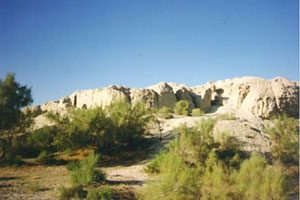
The tomb of the Samanid rulers. Bukhara, Uzbekistan, about 900 AD.
Who were the Samanids?
The Samanids were people who lived in the easternmost part of the medieval Abbasid Empire. They got power in the 800s AD.
The Abbasid Empire
All our Islamic Empire articles
All our Central Asia articles
Samanids or Sogdians?
The Samanids were pretty much the descendants of the Sogdians who lived in that area before them. There’s no big change; we just call them the Samanids in the Middle Ages.
Who were the Sogdians?
More about Indo-Europeans

Snow in Afghanistan
Like the Sogdians, the Samanids were Indo-Europeans. But their rulers had converted from Zoroastrianism to Islam. Samanid people mostly spoke Persian (not Arabic) even though they followed Islam.
Samanids and Sassanians
The Samanid rulers were families descended from the old Zoroastrian aristocracy of the Sassanian Empire. They had converted to Sunni Islam too. Not everybody followed Islam. Some people must have been Mazdakites, while others were Christians or Buddhists.
More about the Sassanians
And about Islam
Samanids and Samarkand

Uzbekistan
Samanid rulers mostly supported the Abbasids and copied Abbasid government. They were technically part of the Abbasid Empire, though really they were pretty much independent. One of their capital cities was Samarkand, the old capital of the Sogdians.
Samanids and the Silk Road
Like the Sogdians before them, the Samanids kept on traveling between West Asia and China as traders. Samanid coins were the common currency of the Silk Road in the 800s and 900s AD. Even people as far away as the Vikings in Scandinavia often used Samanid coins.
More about the Silk Road
And the Vikings
Tang Dynasty China
Samanid education and art
As educated traders, the Samanids ran a kingdom that supported education and art. They attracted scholars like the scientists al-Razi and Ibn Sina.
Who was al-Razi?
The scientist Ibn Sina
Medieval Islamic science
The Samanids probably brought crucible steel technology from India north to Afghanistan, Iran, Turkmenistan, and Uzbekistan. The Samanids sold steel to the Vikings and to China. They also supported Islamic architecture. They built mosques and palaces all over Central Asia.
History of steel
What is a mosque?
What happened to the Samanids?
By the year 1000 AD, the Samanids lost power to the Turkish Ghaznavids and the Karakhanids. From then on, those people ruled this area instead.
The Ghaznavids
Bibliography and further reading about the Samanids: